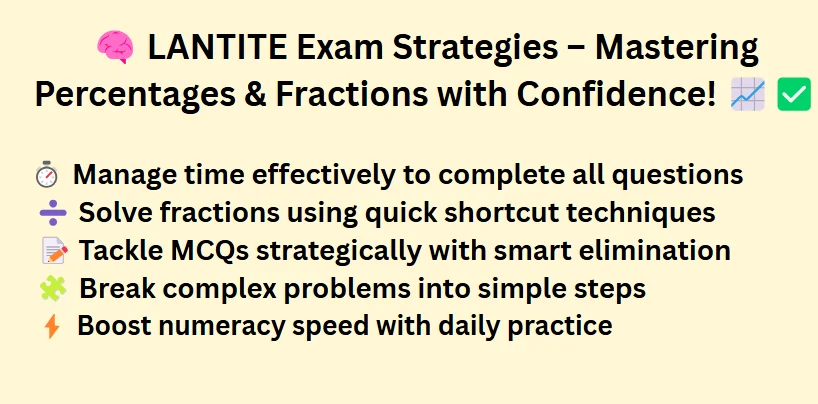Percentage questions practice test for the Math and numeracy concepts is very necessary. If the student wants to prepare for the LANTITE numeracy section, then they must practice the percentage section. Percentage questions also have their weight and importance. 4 to 8 questions come in every Lantite window test, so students must practice this topic of math.
Why is the LANTITE Percentage Important?
LANTITE percentage is of great importance in LANTITE exam preparation because it involves percentage calculations and mathematical reasoning. Understanding ratios and proportions is essential to building a strong problem-solving framework to achieve numerical accuracy through percentage problem-solving. Since exam scoring criteria are based on rigorous principles of testing, understanding and applying real-world percentage use is essential.

Understanding percentage concepts improves test-taking strategies, especially for the teacher qualification test. In addition, it helps in improving numeracy skills and facilitates the use of statistical reasoning and applied mathematics. Applying percentages in daily life is essential for LANTITE exam success. Learning percentage formulas through structured math learning helps in achieving success in standardized math tests.
Percentage application is not only important for numerical proficiency and data interpretation but also helps in percentage-based assessments. It is especially important to master skills like fraction-to-percentage conversion. Promoting logical reasoning in math improves accuracy in test calculations and can strengthen foundational math skills.
Key Percentage Concepts Every Teacher Candidate Must Know
To excel in the LANTITE numeracy test, teacher candidates must master fundamental percentage calculations and related mathematical concepts, including:
- Numerator and denominator distinctions
- Equivalent fractions and their applications
- Mixed numbers and improper fractions
- Fraction simplification techniques
- Decimal and fraction conversion
- Fraction operations (addition, subtraction, multiplication, division)
- Proportion and ratios for solving real-life problems
- Number sense and its role in foundational numeracy
- Quantitative reasoning for effective problem-solving strategies
- Classroom teaching techniques to explain fractions in daily life
Developing a solid grasp of these concepts ensures teacher candidates are prepared for the K-12 math curriculum and able to foster conceptual math understanding among students.
How to Solve Complex Percentage Problems in LANTITE
The LANTITE fraction test questions often include complex fraction equations, requiring strong analytical skills. Here’s how candidates can tackle these effectively:
- Solving improper fractions by converting them into mixed numbers
- Algebraic fractions and their simplification techniques
- Fraction multiplication and division strategies
- Step-by-step math solutions for accuracy
- Numerical reasoning in LANTITE for efficient calculations
- Fraction word problems strategies for real-world application
- Breaking down complex math problems into manageable steps
- Test-taking strategies for fractions to reduce errors
- Time-saving math techniques for quick solutions
With consistent LANTITE math practice, candidates can improve their fraction problem-solving skills and increase accuracy in calculations.
Avoiding Common Mistakes in Percentage Questions
Many candidates make common fraction errors in the LANTITE numeracy test. The most frequent mistakes include:
- Miscalculating fractions due to incorrect operations
- Numerator and denominator confusion, leading to wrong answers
- Fraction simplification mistakes, affecting accuracy
- Decimal point misplacement, causing misinterpretation
- Misunderstanding word problems, leading to incorrect solutions
- The wrong fraction operations are applied in calculations
- Missing steps in calculations, resulting in partial marks
- Test anxiety impact on math, affecting performance
- Strategies to reduce errors through careful checking
To avoid these issues, candidates should focus on improving calculation accuracy, practicing fraction problem-solving best practices, and learn test-taking strategies for accuracy.
LANTITE Exam Strategies – Mastering Percentage with Confidence
Success in the LANTITE numeracy test requires a combination of exam preparation guides and effective test-taking strategies. Candidates should:
- Manage time effectively to complete all questions
- Solve fractions efficiently using shortcut techniques
- Answer multiple-choice fraction questions strategically
- Break down fraction problems into simpler steps
- Improve numeracy speed with daily practice
- Understand question patterns for better predictions
- Practice LANTITE mock exams to gain confidence
- Overcome test anxiety with structured revision techniques
- Master fraction-related questions through repeated practice
- Apply real-world fraction problems to develop understanding
By following a targeted LANTITE preparation plan, candidates can enhance their test performance and succeed in the exam.

Essential Math Skills for Teaching – Percentage and Beyond
Beyond LANTITE, educators must develop core math skills for teachers to support students’ learning. The essential skills include:
- Teaching fractions effectively through engaging methods
- Simplifying complex math concepts for better student understanding
- Numeracy in education as a foundational teaching skill
- Helping students with fractions using visual aids and real-life examples
- Proportional reasoning for teachers to explain relationships between quantities
- Making math engaging through interactive classroom activities
- Classroom numeracy strategies to improve student outcomes
- Lesson planning with a focus on mathematical literacy
With strong conceptual math understanding, educators can create a positive learning environment where students develop confidence in their foundational numeracy skills.
Conclusion
Understanding LANTITE percentage is crucial for teacher competency and success in the LANTITE numeracy test. Candidates must master key math skills, including fraction operations, percentage calculations, and numerical reasoning.
By developing effective test-taking strategies, avoiding common fraction errors, and applying real-world math problems, aspiring teachers can pass LANTITE with confidence and meet the Australian teaching requirements for professional teaching qualifications.
